APA's employees visited the territories liberated by the Azerbaijani Army under the leadership of Supreme Commander-in-Chief Ilham Aliyev and prepared a series of reports from those areas in the "In the Footsteps of Victory" project. Here is the next reportage from this series:
"Bro, I can't sleep," Shamil, who will be traveling with us in a few hours, wrote on WhatsApp.
"So do I." Maybe let's go out slowly? We will drive around the city by car, and then the guys will come,” I wrote back.
We are both excited. But my excitement is understandable, it's usually called "suitcase mood." It happens to most people before the trip, they can't sleep. He did the same to me. And his excitement ...
He writes again: "How many times have I cried ..."
Although Shamil is a lawyer, he is not bad at literature and philosophy. Arguing with penmen and saying "you don't have enough intelligence" has recently become a hobby. So I joke lightly: "The Odyssey is back in Ithaca."
Sends a smiley smile. But he doesn't seem to be joking: "When I think I'm going to Shusha, anger overwhelms me."
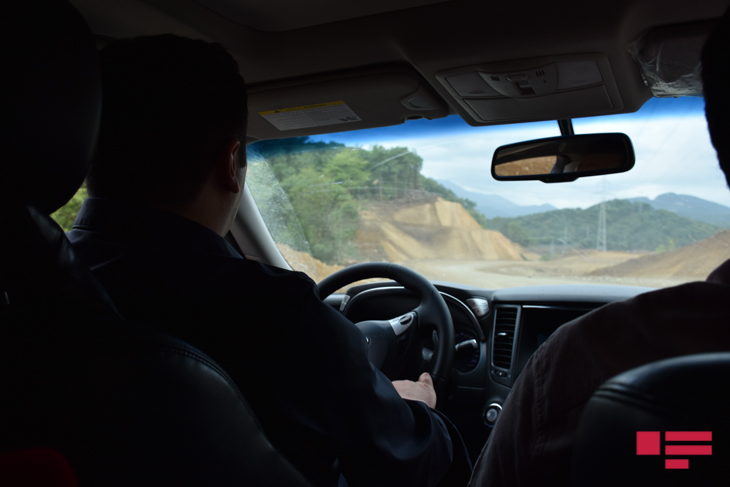
Yes, our visit is to Shusha. The poet said that on a hot, windy summer evening, we will set off with four friends: me, our cameraman Faig, our photographer Ilkin, and Shamil. As part of the "In the Footsteps of Victory" project, we have visited almost all the liberated territories. Only Shusha is left, the peak of our 44-day Patriotic War. Without Shusha, our series of trips would seem incomplete. Finally, this dream came true. We were all excited and happy to learn that we were going to Shusha. Who doesn't want to go to Shusha, to walk around this beautiful city, which has become a legend, to breathe the air and drink the water ?!
There is also the fact that we will see how Armenian destroyed Shusha mosques, tombs, palaces, buildings, house museums, properties ... for 29 years

We are in mixed feelings. And Shamil is ... sad.
Unlike his traveling companions, he is from Shusha. In 1992, when he was 4 years old, he left Shusha. After 29 years, he returns to the place where he was born again. He met me and said while driving around the city until our other friends arrived: “Do you know what is interesting about our night trip to Shusha? We left Shusha at night. My father took my mother and me to ZIL, and he stayed in Shusha. I was sitting in the middle - my right hand was pointing to where I was sitting - my mother was on my right, passing Aghdam through the Armenians, every time the driver pressed my head down and told my mother to bend. Because when Armenians saw children and women, they stopped the car and took them hostage. I was reciting a poem: Don't shoot, Armenians, don't blow up this road ... ”
Shamil speaks, and no matter how much he tries to hide as he speaks, the fragility of his voice captures him. He even seems to forget that he was with me for a while, repeating to himself: "Exactly 29 and a half years ... Exactly 29 and a half years ..."
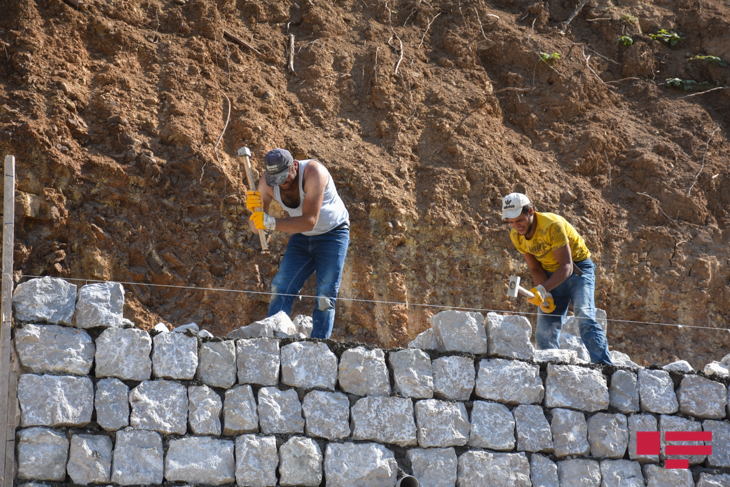
From the very beginning, I will reveal a secret that we will try to find Shamilgil's house in Shusha, so his detailed speech is useful to me, I am collecting material. Maybe he doesn't know, maybe he knows, he doesn't show, but if one of the heroes of this article is Shusha, the other is Shamil.
Our other friends have already come and left the city. As the road is long, we have a lot to talk about: literature, music, everyday life, politics, war, everyday life (we give music when we are tired), but every time we talk like a labyrinth, we come to Shusha, to Shamil's memories.

"Hey," Shamil couldn't hide his astonishment when he saw the "Shusha" sign above our heads, as if for the first time in years he saw an information sign on our roads: "We always looked at it and said, 'Why did they hang it here?' I had to say it was useful. "
As we approach Karabakh, both the relief and the weather change. The plains are first replaced by hills, the steppes by shrubs and trees, and then we will fall into the mountains and forests. There is no need for air conditioning here as in Baku, we open the car windows and breathe fresh air into our lungs. Shamil says: “Yashar Nuri has a film. The children in the boarding school look at the gate at the weekend and wait for their parents to come. That's how we waited for our village when summer came. It was as if the summer holidays made me miss my homeland. Maybe it's strange to someone else, there are people who do not go to the village so much in the summer. Maybe if I was not from the occupied territories, I would not have burned at all. The loss burns a lot. When I sat in the gazebo and felt the warmth of Baku, I remembered Shusha the most. My grandmother was talking about Shusha, other children were going to the village, and I did not have a village.
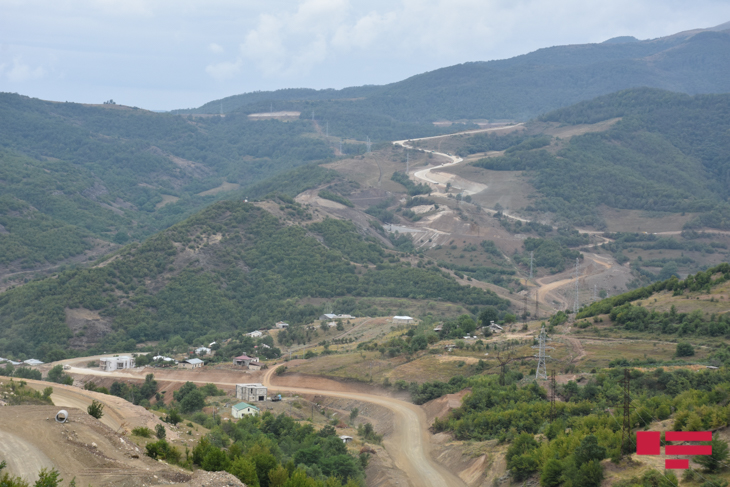
... Listening to Shamil's memoirs, we arrive in Fizuli early in the morning. From there, we enter the "Road to Victory" under construction. This road will take us straight to Shusha. There is nothing left, whether we have a two-hour trip or not ...
We are passing fast through the paved parts of the "Victory Road" and slowly through the rocky places where the ground is freshly fixed.
Construction work is being carried out here at full capacity. We often see heavy trucks carrying soil, asphalt, stones, excavators, tractors, masters building stone dams on the cracked parts of the mountain, and equipment for digging the soil. The "Victory Road" passes in some places along the edge of the cliffs, sometimes through a forest full of trees the height of five-story buildings, and sometimes through a mountain split in the middle. From time to time, we deviate from the main road and turn yellow to the mobile stone processing and asphalt plants built temporarily on the Victory Road, or confuse which direction we will go. Because along with the main road, temporary and auxiliary roads are being built here. Therefore, to get to the main road, we stand on the side of the road and ask the masters who measure the road by leaning on the device in front of one of the eyes, or an excavator digging a hill, the way to Shusha. "From here to Shusha," said the smiling workers, pointing with their hands.
_1628767970.jpg)
This is Shusha. A large plateau surrounded by swollen mountains. Shusha is located in such a geographical area that even the most ignorant people can recognize it from afar. Because among these mountains, there was no other mountain or rock that resembled the mountains and rocks of Shusha. It was as if someone had cut the flat tops of the mountains. I likened Shusha to a tortoise lying more wisely in the distance. It is as if a giant tortoise from mythical times had been lying in the mountains for thousands of years. Considering that the ancients thought that the world was standing on a giant tortoise, Shusha, which is an integral part of our spiritual world, can be compared to a city on the back of a giant tortoise.
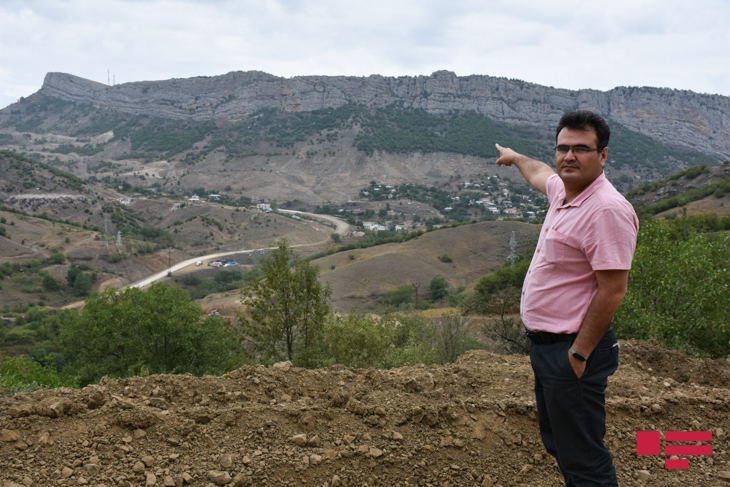
Before entering Shusha, we park our car in the next detour to take a closer look at this view. We watch the hard gray rocks that adorn the outskirts of the city. At that moment, a question is on our minds: "How did our soldiers climb these rocks and capture Shusha !?"
The next day, standing at a height at the entrance to Shusha and looking closely at these mountains and rocks, one of the veterans of the Patriotic War, who did not want to be named and photographed, would humbly say: “We came here on foot from Hadrut for 7-8 days. In the woods, hungry and thirsty. We threw everything we had on the road. We also took a long rope with us. When we got here, we saw that we were surprised and threw it. We climbed those rocks with our bare hands - showing their hands. "
He speaks so quietly, as if they came to Shusha from Hadrut in a car, as if he is not one of the few heroes who gave us the miracle of Shusha, this iron-strong boy.
It is truly a miracle that our soldiers climbed these impassable steep, bare rocks and took Shusha, it is the eighth wonder of the world for us Azerbaijanis ...
Probably, this question will occupy the minds of those who see Shusha for the first time in many years, and they will park their cars in Shusha and watch this miracle created by our heroes.
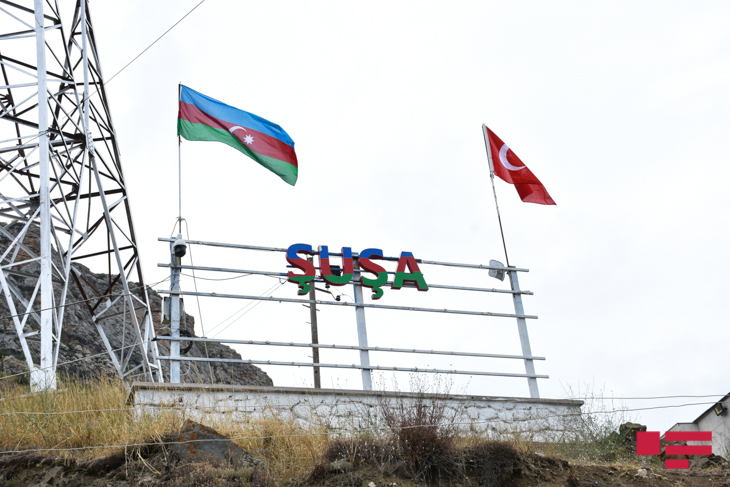
At the entrance to the city, a sign above the post where our soldiers are standing reads "Shusha", and on both sides the flags of Azerbaijan and Turkey are waving. We asked the soldier on duty, "Can we take a picture here?" "It's our land, shoot wherever you want," he says confidently. His words turn my heart to the mountain. If he does not condemn, I would hug his neck with joy, "Brother, look how many years we have wanted to hear this word!" - I would say.
We finally reunite with Shusha. After a while, he will pass the post and for 3 days he will walk the streets of Shusha step by step, walking through the historical monuments - mosques, baths, springs, house museums, ancient estates, witnessing the vandalism committed by Armenians, and we will witness it for you.
"Shot statues"
We first went to the square in Shusha where the "Shot Statues" were erected. Statues of Uzeyir Hajibeyli, Khurshidbanu Natavan and Bulbul were placed in front of the Shusha City Executive Power.
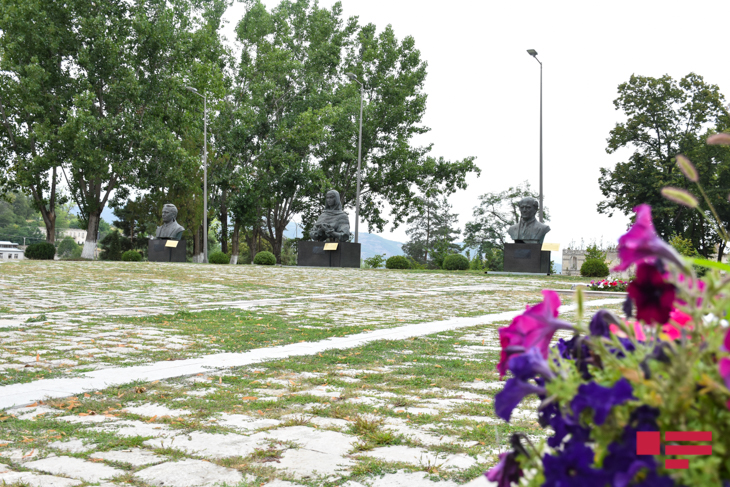
During these 29 years, not only our people, but also our statues were expelled. The sad statues I last saw last year on National Music Day in Baku, in the courtyard of the National Museum of Art, seem to be smiling here. Of course, the statue is a statue, it does not laugh, does not cry, does not rejoice. But we are glad to see the "shot statues" in the occupied territories, and after 29 years of exile, we are glad to see them again in their homeland, and we think that they will join us and rejoice and smile.
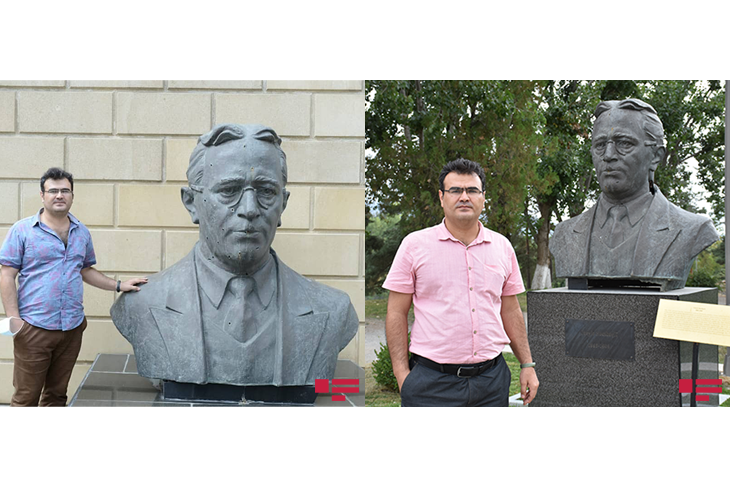
On that National Music Day, when one of the performers said over and over again that the time would come, that these statues would be erected in Shusha, that they would return to their native lands, those words came to me like a fairy tale. I thought I was trying to comfort myself with these words. However, less than two months later, Shusha was liberated. In January of this year, President Ilham Aliyev returned the "shot statues" to Shusha, which were placed in their former place - in front of the former House of Culture. That is why I say "past" because now there are no traces of the House of Culture. During the years of occupation, the Armenians destroyed the House of Culture, as well as most of the buildings in Shusha.
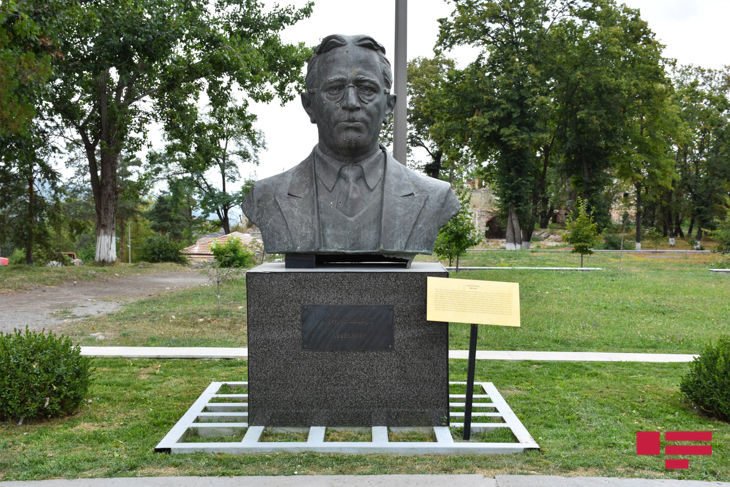
Behind the "shot statues" there is another building with dry walls, the next day we will find out that it is the house of Natava, the daughter of the Khan, and we will go and visit.
Caravanserai of Aga Gahraman Mirsiyab oglu
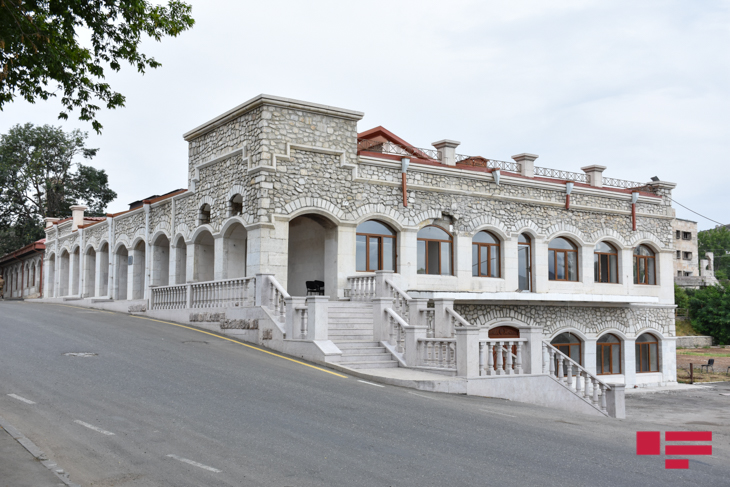
A caravanserai of Aga Gahraman Mirsiyab oglu or Masjidli caravanserai is located on Mirza Fatali Akhundov Street (Rasta Bazar Street), opposite to Shusha City Executive Power. The caravanserai has been registered by the Ministry of Culture as a historical and cultural monument of national importance. It was built in the 80s of the XIX century at the expense of the famous Shusha merchant Aga Gahraman Mirsiyab oglu. This building is still in good condition, it seems that the Armenians used the caravanserai building during the years of occupation.
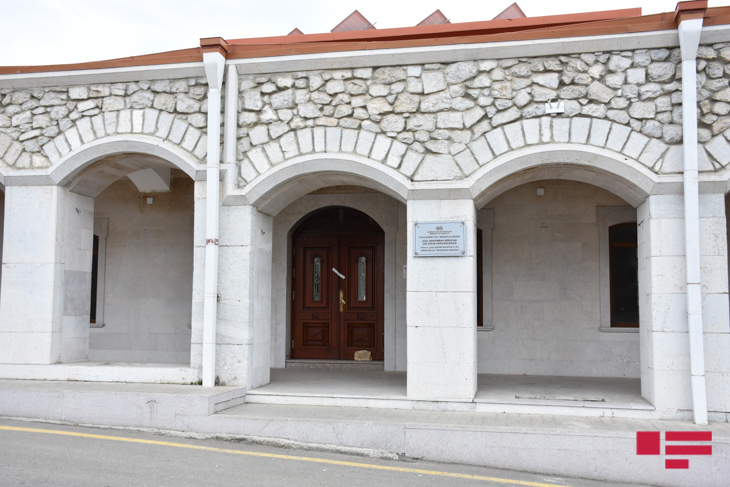
To the right of the descent in front of the caravanserai, the domed building attracts our attention. To be honest, we don't know what it was before. As we approached, we saw that the building was a freshwater bath.
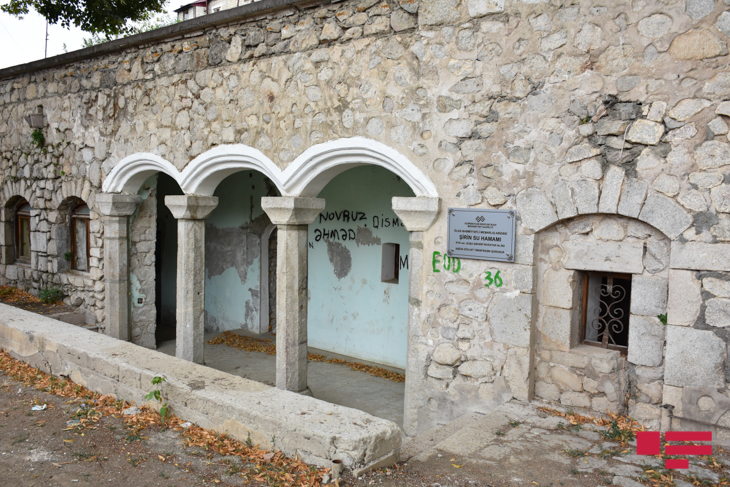
This important architectural monument was built in 1878-1880 by the order of Khan gizi Khurshidbanu Natavan on the basis of the project of architect Karbalai Safikhan Garabaghi. The water of the bath is called "Shirin" (Sweet) water bath because it works with the drinking water brought by Khan's daughter to Shusha. The bath served men on single days of the week and women on double days. This historic bath functioned until the occupation of Shusha.
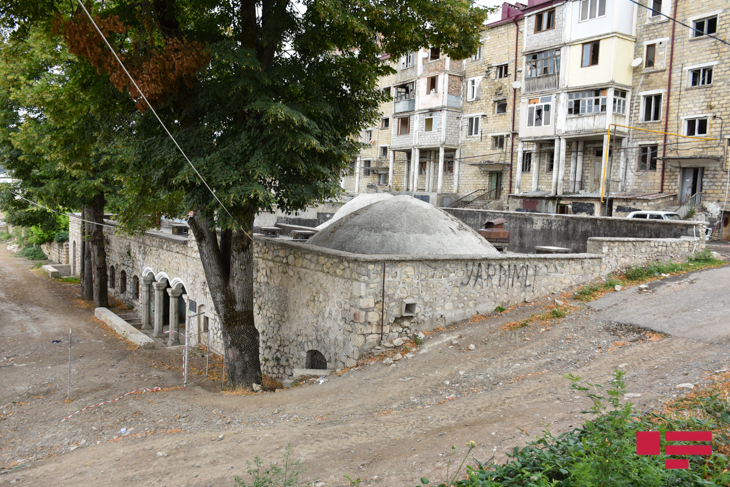

We look into the bathroom. There is a private pool in the center of the common hall, which consists of small arched cells. Unfortunately, the patterns and ornaments on the dome and walls of the hall were completely destroyed. The door to the other rooms opens from the hall, and in the other hall there is a large swimming pool. From the material of the pitcher of the steps leading to the pool, the light ceilings, the plastic doors, it is clear that later the Armenians made some changes in the bath. However, there is a strong stench inside, we can't stop from the filth, we somehow finish our filming and leave.
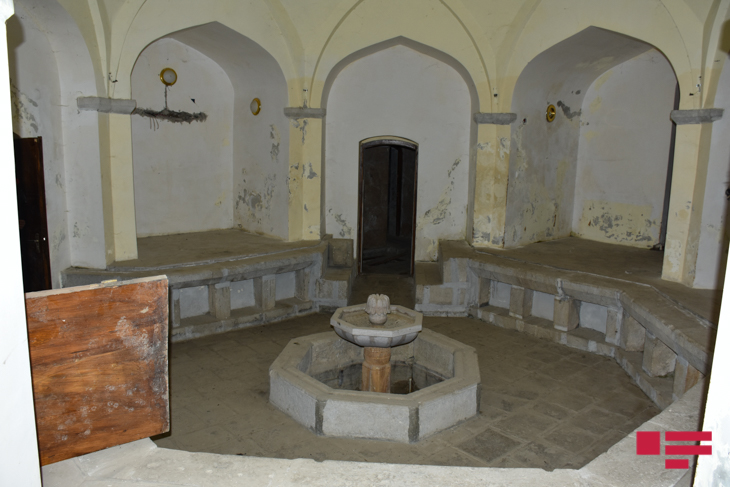
Bayırda isə narın yağış başlayır. Hava dumduru, tərtəmizdir, bir yarpaq belə tərpənmir. Sinənə çəkdikcə çəkmək istəyirsən. Deyirəm, əsl sanatoriya havasıdır, Şamil sözümü kəsir: “Şuşa elə sanatoriya olub də”.
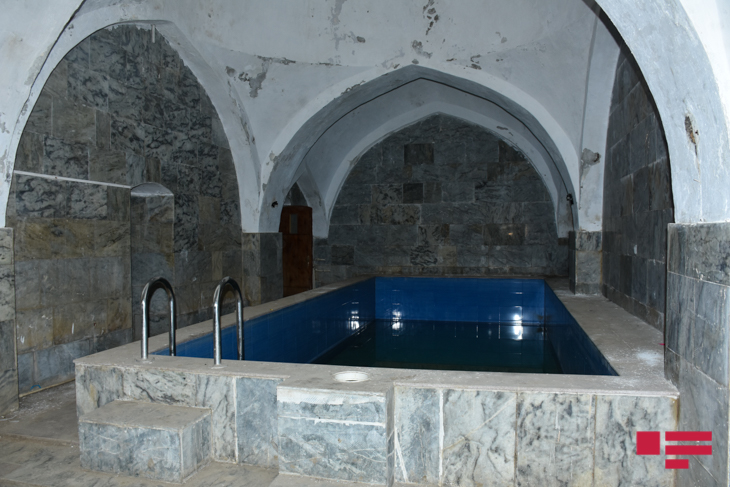
Shamil looks worried. Although I offered to take a guide when I entered Shusha, Shamil did not fit in like a resident of Shusha: "We will find everything ourselves." But now, as I walk the streets of Shusha, I feel that even though I try to combine what I see with Shusha, which I remember many times on Google Maps, nothing works. This is not Shusha, where a four-year-old child remembers, looks at pre-occupation videos and pictures, and talks to his grandmother. This is a completely different place, a looted city. The sadness in Shamil's eyes makes me sad too. Although he does not admit it, despite so much knowledge about Shusha, he has difficulty finding the location of his house. He looks crippled.
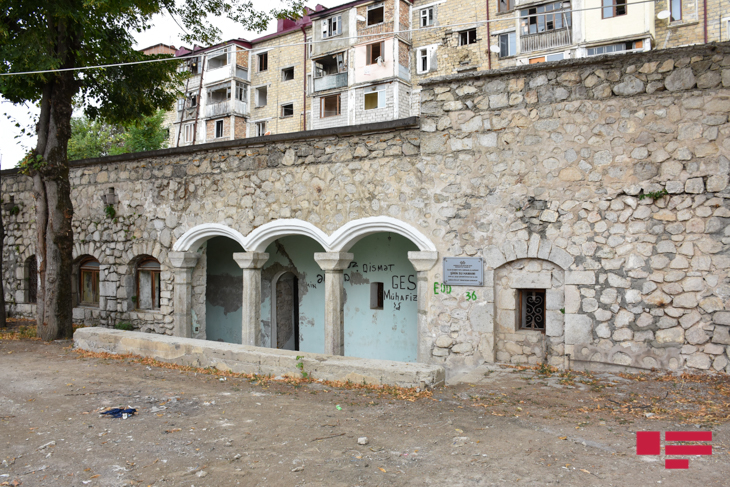
Visitors to Shusha first of all visit the Yukhari Govhar Aga Mosque. We also complete our work in front of the Executive Power and go there. Shamil is still talking to his father, telling about what he saw in Shusha, asking where he is, getting in the car and going somewhere, and then coming back. This continues until we finish filming at the Yukhari Govhar Aga Mosque.
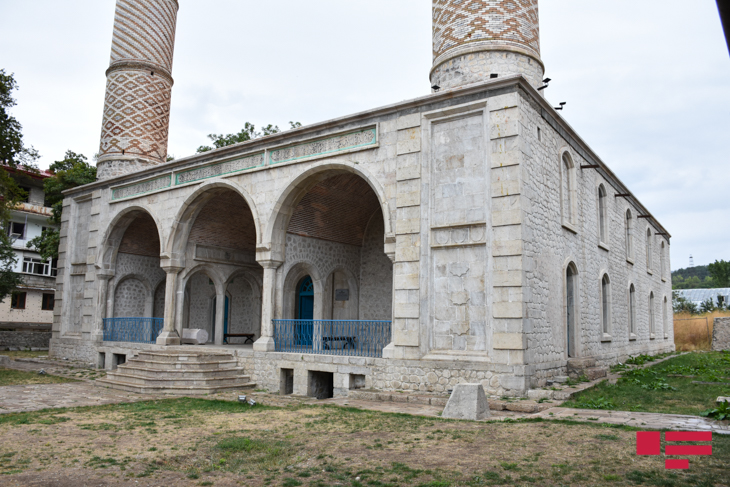
Founded in 1752 by Panahali khan, the city of Shusha was surrounded by fortress walls. One of the features that distinguishes Shusha from other cities is that it was built in parts, not at different times, but in a planned way, as in St. Petersburg. Therefore, the construction of most historical monuments dates back to the XVIII century. The city had 17 neighborhoods, and each neighborhood had its own mosque, bath and fountain. These objects included in the triad were usually built near each other and were named after the neighborhood. Unfortunately, during the years of occupation, most of the mosques, fountains and baths in the city were looted and some were destroyed. The oldest mosque in Shusha is the Upper Govhar Aga Mosque, located in the central square.
Yukhari Govhar Aga Mosque
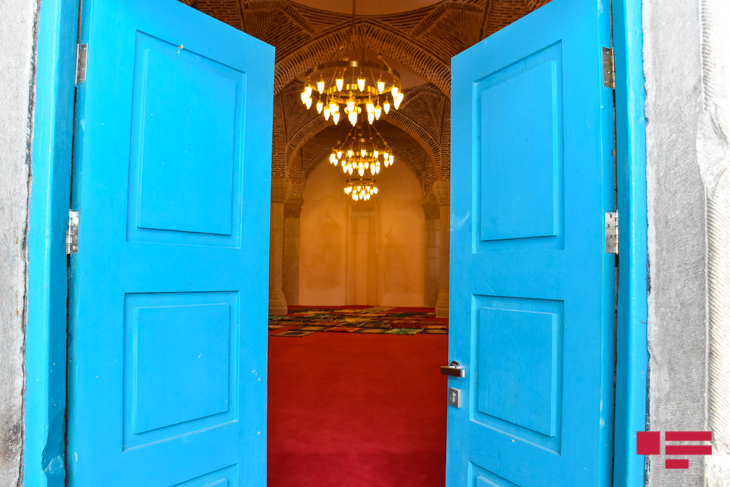
The first mosque here was built of reeds in about 1750 by the order of Panahali khan. After his son Ibrahimkhalil khan came to power, a new stone mosque was built on the site of the reed mosque in 1768-1769. However, this mosque was replaced by a third mosque with a double minaret in the first half of the 19th century with the financial support of Ibrahimkhalil khan's daughter Govhar agha. In 1883, the fourth and last Friday mosque of Shusha was built on the site of the third mosque again at the expense of Govhar agha.
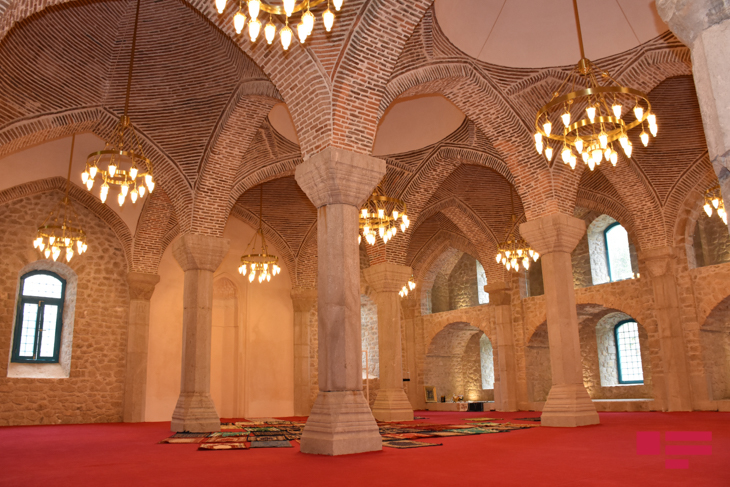
The architect of this well-preserved mosque is Karbalai Safikhan Garabaghi, the author of many buildings in Karabakh. The decor of the minarets of the Upper Govhar Agha Mosque and the murals of one of the rooms on the second floor of the madrasa near the mosque were designed by Mir Mohsun Nawwab, and we will try to find his house.
The arch of the mosque's portico consists of three identical arches rising along the height of the two-storey building. A decorative ribbon with Quranic verses stretches over the arches of the balcony. There are two domes in the middle of the roof of the Yukhari Govhar Aga Mosque, located along the main axis and covering the central nave, with a diameter of about 5 meters. The surface of the brick minarets is divided into three parts by convex ribbons and decorated with colored stones.
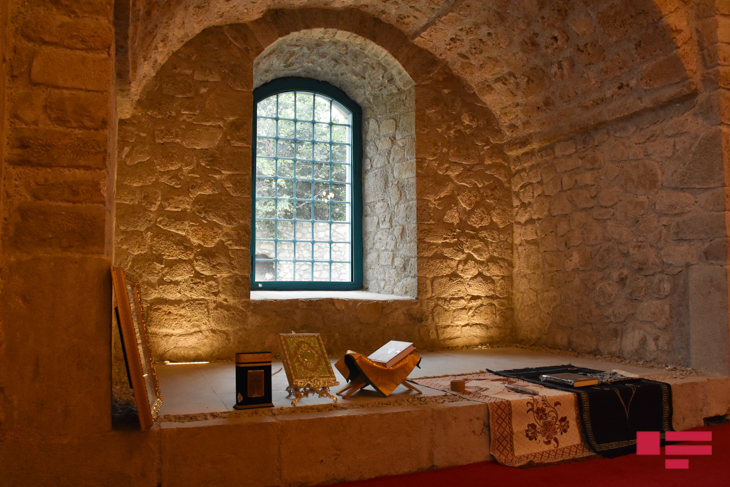
There are about fifteen graves with Arabic inscriptions in the courtyard of the mosque. Unfortunately, I will not be able to give detailed information about whose graves they are. Apparently, some members of the khanate family or influential believers were buried here. In the courtyard of the mosque there is a madrasah, which is considered a historical monument of local importance, part of which was demolished during the Soviet era and a garden was built in its place.

The rain has not stopped yet. Getting rid of the heat and storm in Baku and falling into the autumn air in Shusha is a different pleasure. On the one hand, the sound of the piano. Rising from a nearby building. Someone is playing. Azerbaijani music spreads in the streets of Shusha performed by an unknown pianist. We get a little closer to the building and listen. No matter how amateur the performance is, at this moment, in the courtyard of the Yukhari Govhar Aga Mosque, in the center of Shusha, the resurgence of our music in Shusha makes one happy, gives inexplicable feelings. The souls of both Amirov and Suleyman Alasgarov (and others) find peace. Let him be an amateur paino player, let him not play his song correctly, let him pause, let him play, let Azerbaijani music roam in the skies of Shusha, let him wake him up like an electric shock, let him wake up from 29 years of sleep, clean him from foreign noises, gunshots, Shusha to become a music-mugam center again; Let him play music, sing, sing ... From now on only mugham bells, tar sounds, piano sounds can be heard from Shusha.
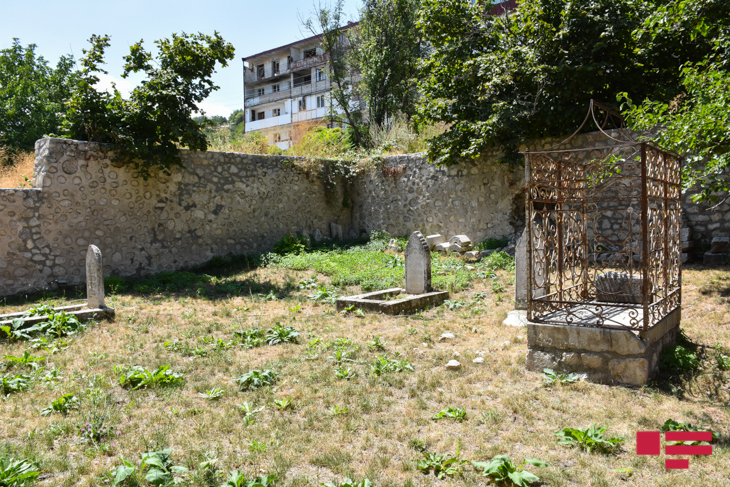
Meanwhile, Shamil's car appears on the square again. I feel like he wants to get away from us and go somewhere. Apparently, he has learned the location of their homes and is probably going to find them. But we are going to leave him alone. We get in the car, go up the road to the right of the Yukhari Govhar Aga Mosque, and then turn right in front of the green-walled building.
Apparently, Shamil realizes that he will not find his way home and gathers his father again: "Dad, after falling five stories, should I turn right, left?"
"You don't fall," says his father, "from the front of the five-story building ..."
"Aha, you mean the five floors in front of Govhar Aga?" - Shamil asks again.
"No, you pass Govhar Agha, then you turn right," insists his father. But after a while, the road to the right comes to a standstill.

Biz maşınımızı geri verənə kimi atası xəttin o başından izahatına davam edir: “Oraynan düz gedirsən, təzə məhlə bulağı var, oranın suyu gəlmir, bir də orada yaşıl aptek var. Mehmandarovların evini keçirsən, sağa dönürsən, düz əlli metr gedirsən, mən tikdirdiyim evdir. Böyründə də Arazgilin evi”.
Amma Şamilin atasının yolu izah etməsinə baxmayaraq, istiqaməti tapa bilmirik. Eyni yerdə dolaşıb dururuq.
“Beşmərtəbənin yanından sağa dönən kimi torpaq yola çıxır” - Şamil telefonda atasına deyir.
“Qabaq asfalt idi, indi nə bilim. Bircə dənə yol var də”, - atası şikayətlənir.
Şamilə deyirəm ki, evlərinin yerini belə axtarmaq çətin olacaq, “Whatsapp”la görüntülü yığsın.
“Ağıllı varinatdı”, - Şamil zarafata salır.
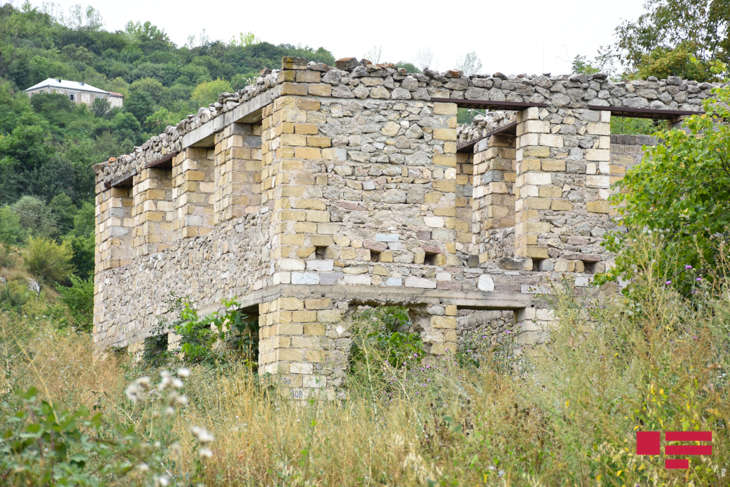
Until we return our car, his father continues to explain from the other side of the line: “You go straight there, there is a new spring in the neighborhood, there is no water, and there is a green pharmacy. You pass the Mehmandarovs' house, turn right, walk exactly fifty meters, this is the house I built. Arazgil's house is next to it. "
But despite Shamil's father's explanation, we can't find the direction. We walk in the same place.
"As soon as you turn right next to the five-story building, the ground starts to move," Shamil told his father on the phone.
"It used to be asphalt, now I don't know. There is only one way, ”his father complained.
I tell Shamil that it will be difficult to find the location of their homes, to makee video call via WhatsApp.
"It was a smart option," Shamil jokes.

My idea really works, after opening the video call, his mother joins the conversation and explains the way home together.
"Don't go to the market, come to the other side of the market. Go straight in front of that five-story building, turn left. Turn left, there was a kindergarten on the right. You will not remember that you were in that garden. "
The iron-fenced kindergarten is still in place. There are colorful paintings of animals on the building in the yard. Apparently, during the occupation, Armenians used this place for its intended purpose. We go through the kindergarten with the praise of Shamil's parents. So, on WhatsApp, we go to Shamil's parents' house to ask questions.
Although Shamil did not feel excited, he managed to drive the car, did not look into potholes, increased his speed when necessary, and there was no trace of the always careful driver.
"It's the Mehmandarovs' house on the right, Shamil," says his father.
"What's next for him?" - Shamil both drives the car and pulls in the direction he said on the phone.
"It was also a mosque, and the road to my grandfather's house passed by it," said his father.
"Go straight from here, turn right, turn right" - His mother joins them.
After 29 years of separation, we are witnessing a father, mother and son hurrying to be reunited with their homes. Scenes like the movie come to life before our eyes.
"I saw," says Shamil, who sees his house in the distance, his voice cold and trying to control his excitement.
His father said, "Do you remember now?"
"This is our home," Shamil said.
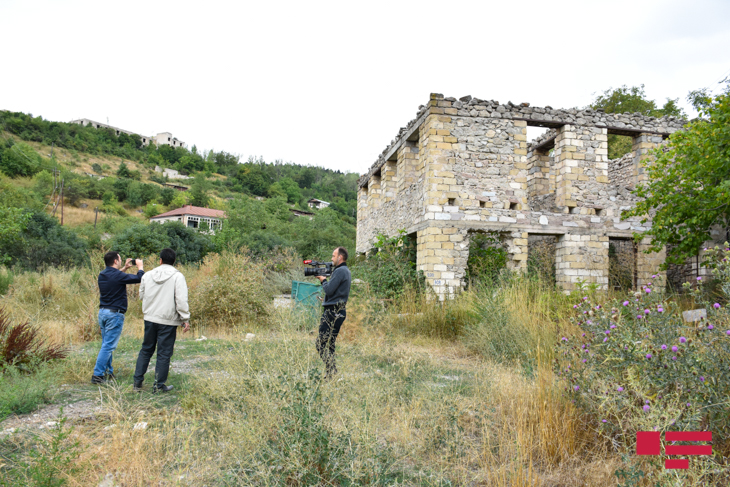
This is Shamil's house, the house he left in 1992. Finally, after 29 years, he is able to return to his homeland. We get out of the car and enter the yard. There is grass on all sides. It has been a sign of life for a long time, maybe 29 years. Even if it is not a two-story house with dry walls, you will never know when people set foot here.
Shamil and I stand in the middle of the yard and look at their houses. If I were in his place, I couldn't stand it, I would walk away, bend down and kiss the ground, rub my face on the walls of our house. Shamil maintains his composure. But I feel that it is very difficult to achieve this.
"Do you remember anything?" - I ask Shamil. "Everything is as my father said. We were repairing the house at that time, we were repairing the second floor. But it was not so, there was grass on all sides. We left here at night. My father was fighting there, he and my mother put me in a car at night and sent me to Agdam. That was the last time I saw this house. I still remember the days I spent here, the sound of the ball, the hail. Our house was being repaired at that time. True, I was a child, but I remember helping the mud mixers in the yard. The windows, doors and everything of the house were taken away, only the walls remained. They did not look after, because it did not belong to them. It is heartbreaking to see this scene. It's like you're in the woods, ”says Shamil.

We walk in the yard. He sees a pile of stones at the bottom of the fence, covered with bushes. "They didn't take part of the stone," he says in surprise.
"The stone you poured?" - I'm asking.
"It was ours," he says.
There is a hazelnut tree on the side of the house, under which there is a rusty table and a bench, and next to it there is a "grid" of an old iron bed against the wall. Shamil says that they are from that time: “We were sitting under this hazelnut tree. I was playing a game here. "
He picks wild blackberries and throws them in his mouth. I say, "It's the product of your yard, eat it." He laughs and says, "Be a guest, it's like it's your yard."
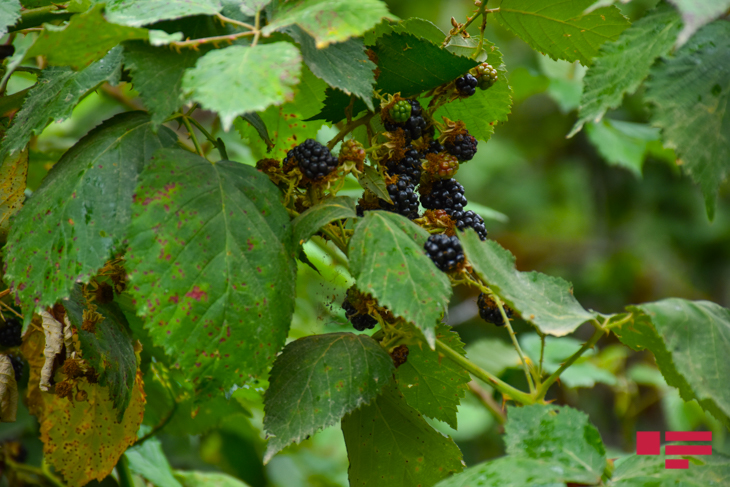
"Look, this house, this yard, just like the bushes, the yard, the house, just like the house, after the occupation of Shusha, our lives were covered with bushes, our lives became such a ruin. The Armenian occupation did not allow us to live. We lived with trauma. Both our childhood and our youth. We had no choice but to return to Karabakh, even though we could spend our dreams and deeds in another direction. It is good that we liberated our lands from occupation,”Shamil continued.
Then we leave Shamilgil's yard to continue filming in Shusha. Then Shamil is left alone at home. Then Shamil cries alone, embracing the stone and soil of his house. Then a baby boy appears in Shamilgil's yard: he runs in the yard, helps the builders, falls, shakes his head, plays with his toys under the hazelnut tree, throws stones at the birds, raises his head and looks at the sky, his eyes glaze over ...
... Then black clouds cover the sky of Shusha ... And the occupation begins!

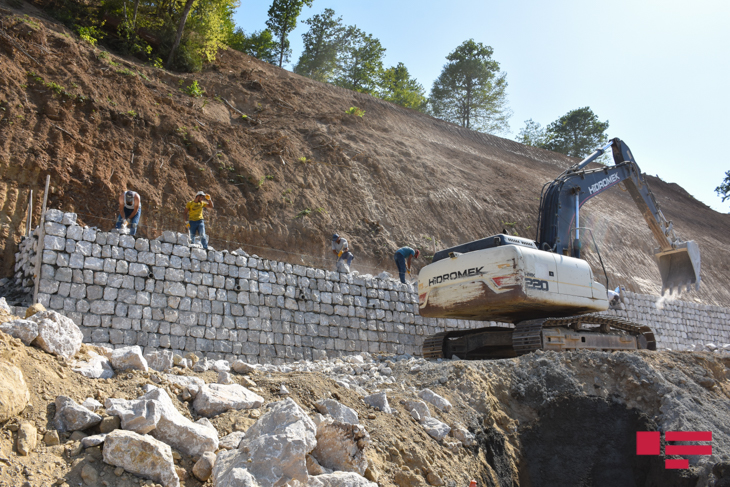

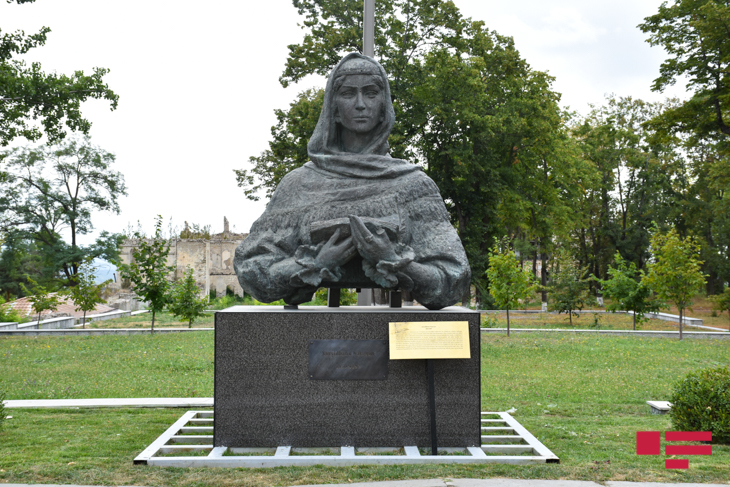
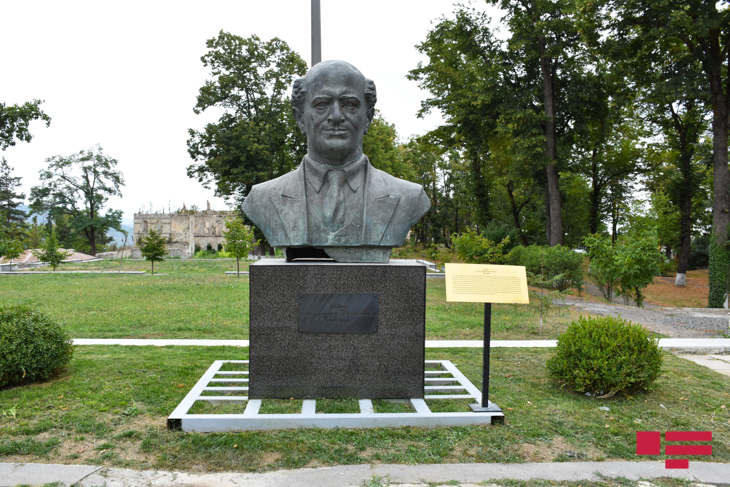
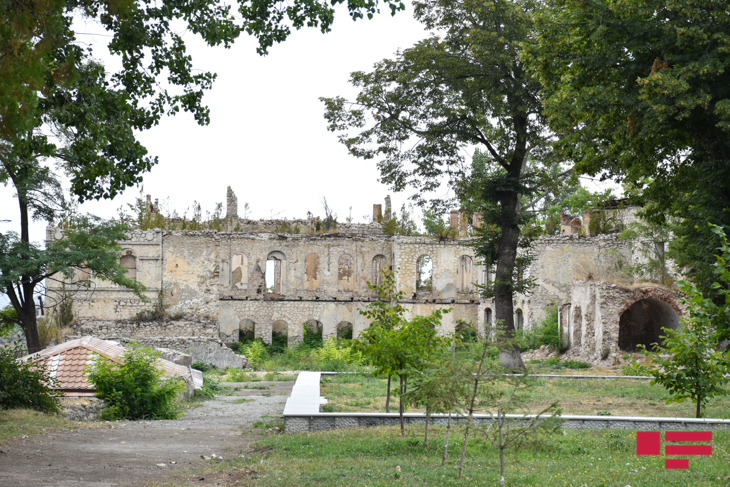
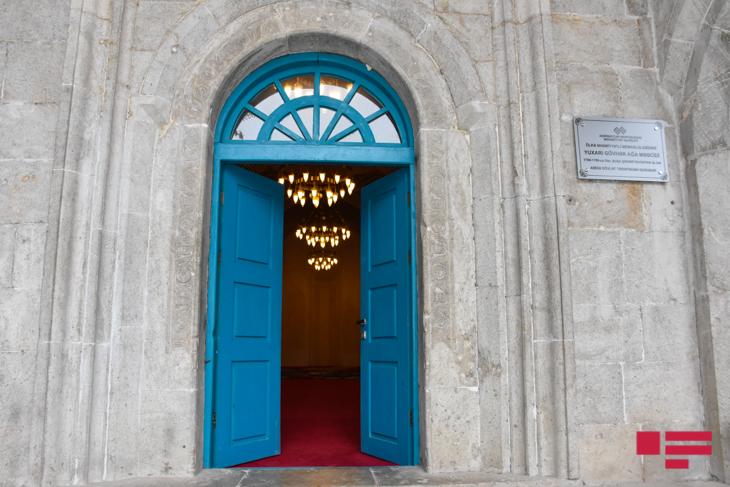
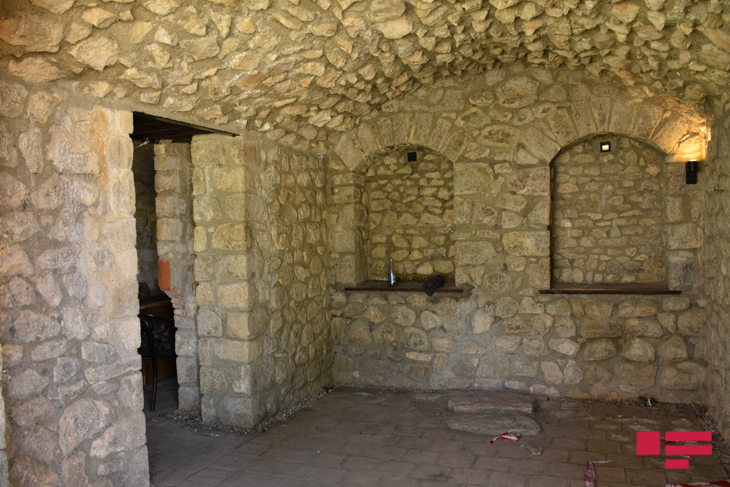




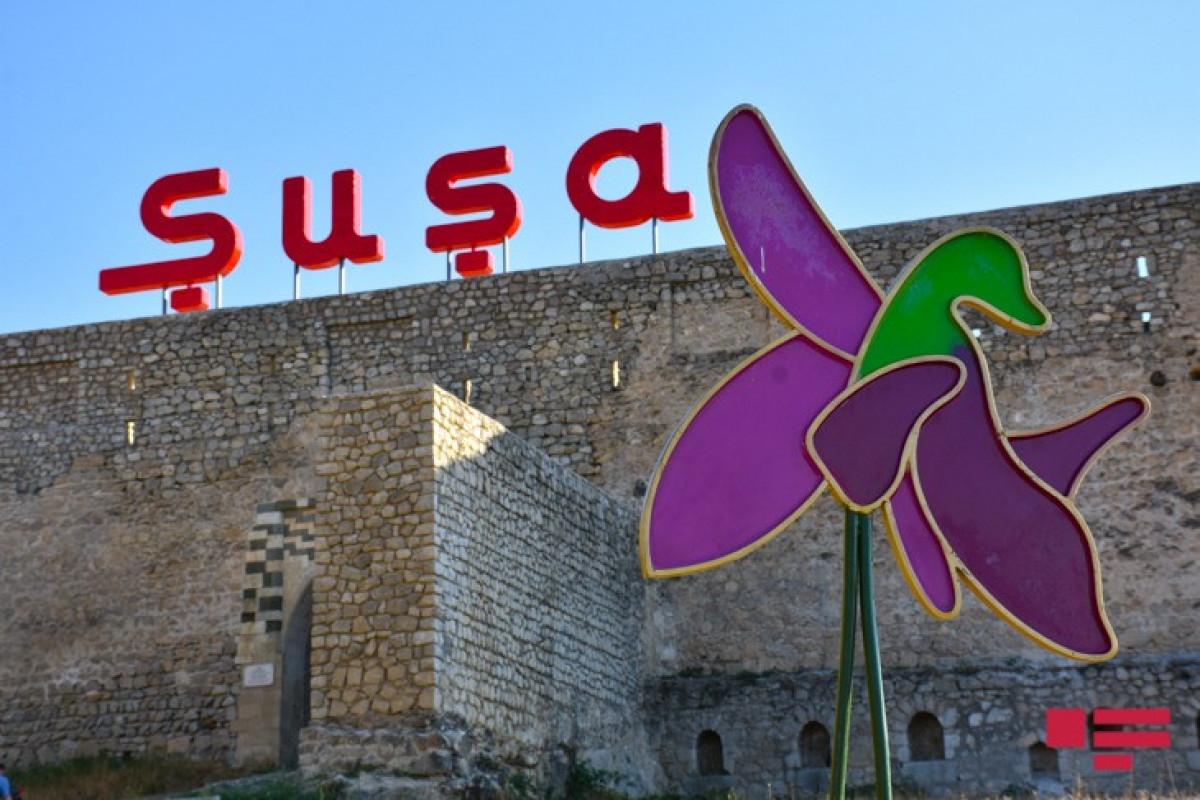


 PHOTO'>
PHOTO'>
